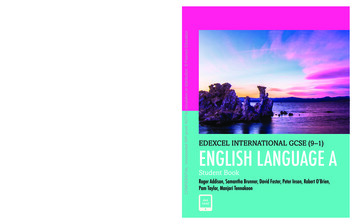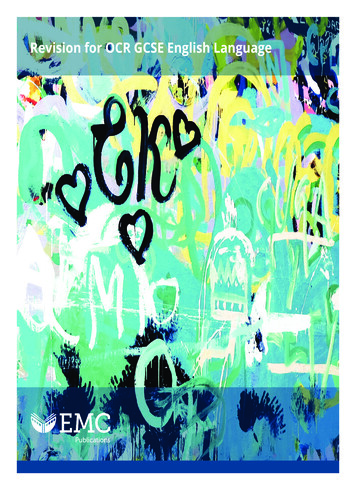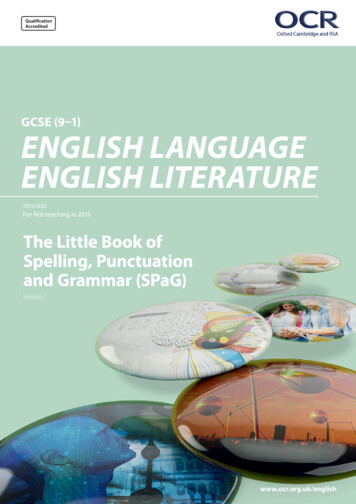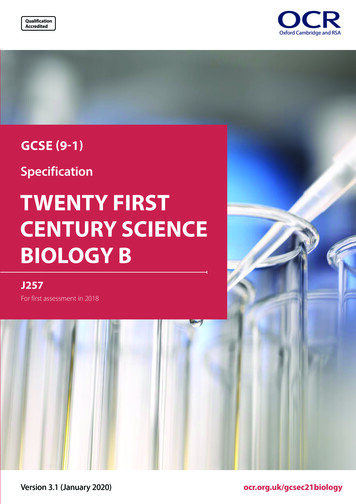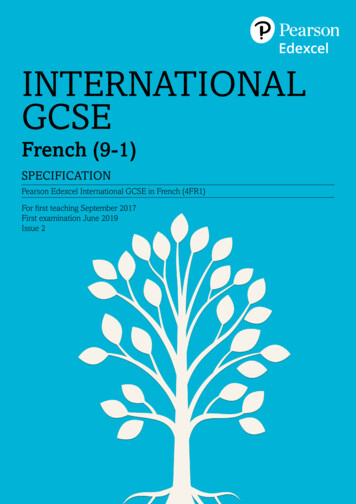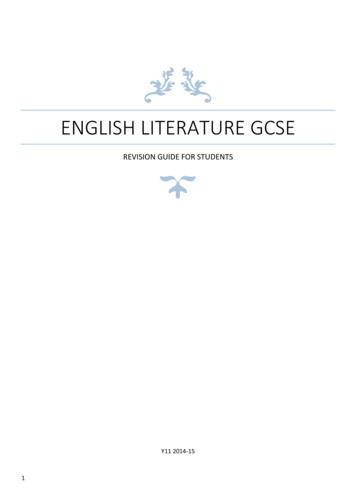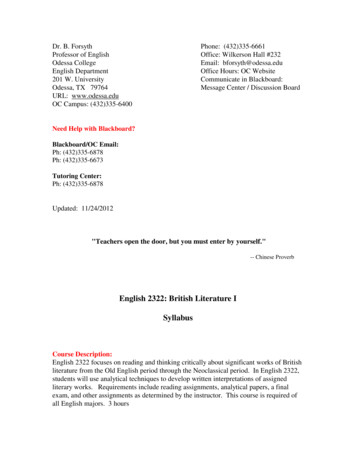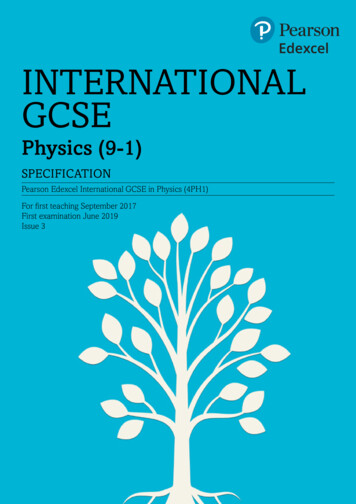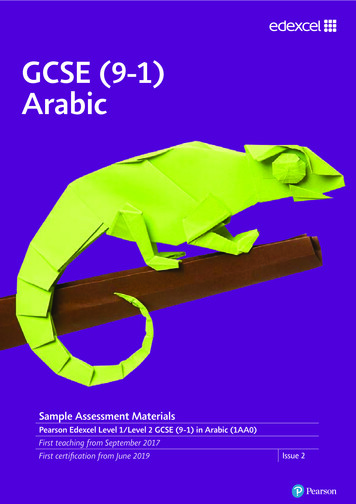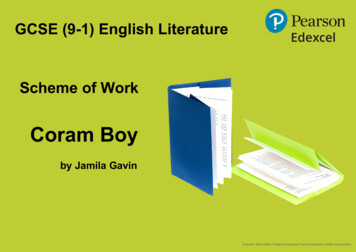
Transcription
GCSE (9-1) English LiteratureScheme of WorkCoram Boyby Jamila Gavin artwork: Mark Bolitho Origami photography Pearson Education Ltd/Naki Kouyioumtzis
Coram Boy - Scheme of workCurriculum Intent: To engage with the issues presented in a text through dicussion and analysis.Implementation: As part of the GCSE requirement for English Literature learners will study a range of post-1914 dramas/novels and thisplay will form part of the GCSE literature studyAssessment Objectives:AO1: Read, understand and respond to textsStudents should be able to: maintain a critical style and develop an informed personal response use textual references, including quotations, to support and illustrate interpretationsAO3: Show understanding of the relationships between texts and the contexts in which they were writtenAO4: Use a range of vocabulary and sentence structures for clarity, purpose and effect, with accurate spelling and punctuation2
e tasks1AO1 – Interpretation ofauthor’s forewordBig question: What role should we all take to protect children insociety?AO3 – Explore somecontextual ideas raisedby the author’sforeword. Discuss/write responses to big question.Provide a ‘bag of objects’ related to childhood[bottle/dummy/toy/novel/food] or project objects ontowhiteboard – ask which are essential for children.Give students a selection of key words from first page ofauthor’s foreword to the novel [abandoned, children,pathetic, orphanage, highways, brutalised, etc] and ask forsome plot predictions.Explain that the novel is set in eighteenth century – doesthat change how they relate to the words? Are any stillrelevant today?Give out copies of first page of author’s foreword to novel.Read carefully, discuss/explain unfamiliar contexts, couldproject accompanying images of foundling hospital tobroaden es/ links toGCSE English LanguageCopies of first page ofauthor’s foreword.Homework: Give out researchprojects: Coram hospitalLife at Eton College [in1700’s and now]Parish orphanages in18CThomas CoramPlenary: Revisit big question.Big question: How should society treat the less fortunate? In groups students should have the following statement cutup into short words/phrases and be asked to re-assemble:3
The way a nation treats its poor and unfortunate citizens, mostespecially its children, is a mark of how civilised it truly is.[variously attributed to Gandhi and Hubert Humphrey] 2AO1: Explorecharacterisation andevents in openingchaptersAO3: Explorecontextual issues raisedin opening pagesProject pictures from 18c paintings of childhood/societyand discuss statement in relation to them. Or providebackground information about life for children in 18C.Broaden discussion to modern day – has society changed?Give students a chapter title from the novel that can berelated to the statement. Ask them to interpret the title inthe light of the statement.Think/pair/share activity on chapter titles.In groups or as a class, encourage use of imagination andinterpretation to create a narrative by putting chapter titlesin order.Plenary: Return to big question and relate it to today’slearning.Big question: Do we still need superstitions in our modern digitalsociety? Take feedback on big question.Extension - Project the first line of the Prologue and ask forreactions – why do people go to fortune tellers? Why don’tthey?Project the word ‘Prologue’ – ask for meaning.Explain/discuss the purpose of a prologue.Hand out copies of the prologue without the finalnursemaid/child dialogue [end with ‘as she ended’.].Copies of prologue and first2/3 pages.Research modern orphanagecharities.4
Students to write the dialogue. Compare with author’s –discuss differences – relate them to context, are theirefforts different due to historical context?Discuss what the prologue suggests about the plot andpotential reader reaction.Hand out copies of the first two pages. Model annotatingfor character mood, reader reaction, context, etc. Studentsto work in groups on page 2/3 with each group to take oneof: character inferences, contextual issues, relationshipinferences, predictions for plot. Take feedback and shareideas.Review homework research. Relate to first three pages.Plenary: why might Meshak need superstitions?Class reading. Aim to read chapters 1 – 3 up to page 38. 3AO1: Explorecharacterisation andevents in openingchaptersEncourage students to record their impressions ofevents/characters by bullet pointing key events andannotating with character ideas/inferences/predictions.Ideally using different pens.Consider introducing/modelling Cornell notes technique forrecording impressions.Big Question: How does Gavin create empathy for Meshak? Take feedback on starter question.Feedback on homework – particularly on Coram Hospitalinformation – link to introduction of Coram in the novel.‘Benchmark’ the plot so far by brainstorming five keyResearch boarding school life. Paragraph usingwhat/how/whytechnique toexplore characters.5
criteria for an effective novel opening. Benchmark the first3 chapters against the criteria.Introduce ‘what, how, why’ as a tool for explaining textualinferences. Students to work in groups on either Meshak orOtis. Consider and mind-map – what Gavin tells readersabout the character, how she tells them [dialogue, events,actions, structure of narrative, etc] and why she tellsreaders this [ie, to create empathy, to create tension, toprogress the plot, to create an enigma].Discuss female characters – brainstorm what role theymight have in the plot going forward. Are readers invited tolike or dislike them? And why?Plenary: return to starter question using what/how/whyideas.Class reading. Aim to read chapters 4 - 6, pages 39 - 85 4Encourage students to record their impressions ofevents/characters by bullet pointing key events andannotating with character ideas/inferences/predictions.Ideally using different pens.Create a tension graph template covering all chapters sofar, begin to track tension whilst reading.Big Question: School days – the best days of your life?AO3: Link events andcharacters tocontextual issues Students to complete because/but/so sentences toconsider big question. Half the class should complete threesentences as Thomas and the other half as Alexander.Take feedback on ish Language Write an article fora local newspaperentitled ‘Schooldays – the best daysof your life?’.6
Divide class into two groups:o One to read the BBC article about Barnados[perhaps provide other resources about the charityor similar orphanage charities]. Make notescomparing Barnados to the orphanage in the novelbefore it is improved by Lady Ashbrook.o One group to read background information on Etonschool and compare to life at the Cathedral school.Or compare their own school life with that in thenovel. Discuss and list the range of contextual issues raised byboth the parish orphanage charity and the school lifeexperienced by the boys [charity, responsibility, society,gender, childhood, class, etc] Model linking the admiral’s speech on page 84 to acontextual issue. Students to practise linkingevents/characters [eg the admiral, Lady Ashbrook, Thomas]to context using what/how/why technique. Plenary: return to big question in the light of contextuallinks – for which character is school the best days, and why?Class reading. Aim to read chapters 7 - 9, pages 86 - 118 Encourage students to record their impressions ofevents/characters by bullet pointing key events andannotating with character ideas/inferences/predictions.Ideally using different pens.Use timeline or body shape ideas to explore/record thedifferences between Thomas, Alexander and Meshak.7
5AO1: Explore themesand make links tocharacterisation,setting and contextAO3: Examine thecontextual issues raisedat this stage in thenovelBig Question: Why study the arts? Silent debate using contentious statements about the roleof the arts in society. Take feedback and relate toAlexander’s expected role as an aristocratic male.Come up with a list of key themes covered so far in thenovel [charity, responsibility, childhood, courage, gender,exploitation, reputation, poverty]Write themes down one side of the board and characternames down the other. Students to link as many across theboard, perhaps using what/how/why to ensure detailedresponses.Students to work in groups to draw each of the importantsettings so far [cottage, Ashbrook house, orphanage,Cathedral school, etc]. Model annotating with keyquotations/ideas/inferences linking key settings to themes,context and character.Plenary: return to big question and consider which boy hasthe greatest chance of happiness in life.Create an ingredient list for agothic novel.Analyticalparagraph aboutsetting.Class reading. Aim to read chapters 10 - 12, pages 120 - 158 Continue recording impressions of events/characters andplotting tension graph.Begin a theme chart – courage, parenting, gender roles,exploitation, reputation, poverty, hierarchy, class,childhood, hypocrisy etc. Nominate one or two studentsper lesson to each theme and ask them to take notes to addto class chart.8
6AO3: Explore ideasabout genre of novelBig Question: Is the novel a gothic adventure or an epic love story? Think/pair/share ideas about the big question.Take feedback on homework and compile class ingredientlists of both gothic and love genre novels.Work in groups to benchmark the novel against both lists.Using the opening and the ending of chapter 10, studentsto re-create them as film openings in either the gothic orthe romance genre by drawing/storyboarding. Encouragethem to use classic film conventions for each genre.Discuss reader expectations of each genre at this stage ofthe novel.Plenary: how relevant is the novel’s title at this stage in theplot?Research historic attitudes tobabies born out of wedlock.Perhaps by giving studentsdifferent eras from 1700 tothe present day.English Language –evaluation of filmopening.Class reading. Aim to read chapters 13 – 15, pages 160 - 182 Continue recording impressions of events/characters andplotting tension graph.Encourage predictions about the plot of the second half ofthe novel.Start a class genre chart – add genre conventions found ineach chapter with reader response.9
7AO1: Develop aninformed personalresponse to eventsAO3: Explorecontextual issues andcompare to modernsociety.Big Question: ‘I cannot live without music’ – is Alexander selfish toleave his family? Odd one out starter with character names. Extend byselecting odd one out based on categories theme/context/reader response Think/pair/share ideas about big question. Students to work in groups to explore the contextual andcultural norms and expectations reflected in chapters 9 14; for example, gender roles, unmarried mothers,illegitimacy, family roles, the role of charities, the role ofsociety, etc. Examine and contrast contextually, ie whatcultural norms are presented in the novel and how do theycontrast to modern society. Extend the group activity by providing a selection ofquotations from the chapters such as: page 174 “If Iabandon it, it will surely die and if I hand it in, then myname will be known and I and my daughter will be ruined.”Encourage students to examine these in the light of currentsocietal norms, for instance, helping a young mother wouldbe seen as a positive act now. Plenary: revisit the starter big question in the light of thelesson’s exploration of context.Homework: Students to findarticle from newspaper[ideally print] that relates tothe cultural ideas explored inthe lesson. Link ideas in thearticle to the novel.Quotationexplosions –students to write upas a paragraph ofinterpretation ofcharacter or theme.10
Silent reading. Aim to read chapters 15 - 17. Pages 183 - 215 8AO1: Explore thenarrative perspective.Big question: Who is the luckiest character so far in the novel? AO3: Explorecontextual ideas aboutslavery.AO1: Write in a criticaldetached style.Continue recording impressions of events/characters andplotting tension graph.Note points of foreshadowing/reveal and explore readerresponse. Discuss or use silent debate technique to explore the bigquestion.Provide background information on slavery [use links] andcharity organisations in Britain in the 18th century. Ingroups they should create ‘context cards’ [ie, a fact abouthow slaves were treated, a fact about charity organisations]In groups they should play ‘text as a pack of cards’ – createcharacter cards and theme cards to use alongside thecontext cards. Each student to have a selection of each andto hold them up in turns – other students win the card ifthey can link it to one of their cards. Winner is the studentwith the most cards at the end.Practise ‘what/how/why’ technique to explore ideas abouthow slavery and charities are represented in the novel sofar.Plenary: quotation race – who can find evidence ofhypocrisy about slavery and charity? Use these to revisitthe big question.http://www.bbc.co.uk/history/ English Language british/abolition/industrialisat report on the stateion article 01.shtmlof the orphanageusing evidence fromhttps://en.wikipedia.org/wiki/ chapter 15.Slavery in ofmemory/black-lives-inengland/Teacher reading. Aim to read chapters 18 – 21. Pages 216 - 256.11
9Split class in groups of three and number themselves 1 – 4.Teacher to read aloud whilst number ones takes notes,number twos draw images and number threes listen butwrite nothing. At the end of each chapter students tocompare recall and ensure each has detailed chaptersummary. Students could swap numbers for each chapter.Plenary – which method provided most detailed recall?AO1: Develop anBig question: Nurture or Nature?informed interpretationof the narrative Discuss the starter question in relation to the boys in thetechniques.novel. Consider whether ‘nurture’ has more impact nowthan it did in the 18C.AO3: Explore how Display two images; one a christening robe and one asymbolism is used tonecklace of African beads. Explain symbolism and askportray contextualstudents to debate which is the most personal, poignant,ideas.valuable, etc and why. Ask students to come up with ideas about other symbolicideas, objects or settings in the novel [for instance music assymbolic of freedom, the cottage as symbolic of childhood,the orphanage as symbolic of the oppression of the workingclasses] Allocate students [in groups or individually] a page of thenovel and challenge them to identify the dominantnarrative technique used; for example –description/dialogue/feelings/action. Share findings withclass and explore the way each technique helps to developideas about characters, themes and context. Plenary: challenge students to find evidence that nurtureResearch into modern slaveryParagraphinterpretingevidence ofsymbolism.12
was as important as nature in the 18C.Class reading: Aim to read chapters 22 - 25. Pages 257 - 295. 10AO1: Form an informedpersonal response to alinked poem.AO3: Consider how farthe novel is anexploration of keyissues today, or in thepast.AO4: Use a range ofvocabulary andsentence structures forclarity, purpose andeffect, with accuratespelling andpunctuationBefore reading, project the final line of chapter 21 ‘”I’veseen that man before”’ and ask for predictions about whothe man might be. Encourage students to back up theirpredictions with relevant and specific evidence from thetext.Focus on narrative techniques whilst reading.Big question: Are you guilty if you stand by and do nothing? Brief discussion about the starter question in relation to theCoram baby scandal in chapter 24.Introduce the poem ‘London’ by William Blake, perhapsusing Hogarth’s ‘Gin Lane’ and asking students to annotatewith ideas about life in the late 18C. Can students link thepeople in the poem with the people in the novel?Using the poem, the image and the novel, come up with asummary of what life was like during that period. Can theysum up the period in a single word? [ie turbulent, harsh,exciting].Consider whether Gavin is making a point about 18C, orboth that era and the present day.Introduce a sample exam style question: ‘Explore thesignificance of hardship in the novel.’ Brainstorm ideas as aclass. If time, model writing a paragraph and emphasising adetached critical style.Research educationalopportunities for the poor in18C.Paragraph of examanswer.13
Class reading: Aim to read chapters 26 - 30. Pages 296 - 331. 11AO1: Explore Gavin’suse of narrativeperspective.Big question: How does our society handle its ‘poor andunfortunate’? AO3: Explore how thenovel presents acontextual issue.Encourage the creation of a tension graph for the finalchapters.Revisit question [and homework] from earlier lesson aboutthe quote: The way a nation treats its poor andunfortunate citizens, most especially its children, is a markof how civilised it truly is. Use this statement to frame adiscussion about how Meshak is treated in the novel. Havea class competition to come up with words/phrases todescribe how people feel about him and how he is treated. Extension: rank the words/phrases in terms ofsophistication and use one to write a what/how/whyparagraph in answer to the question ‘How is Meshak’streatment by others important to the novel?’ Read Huff post article and consider how the writer’s lifediffers to that of Meshak. Use page 292 – 294 as practicefor English Language comparison questions. Plenary: How should society handle its most vulnerablemembers?Class reading: Finish novel. Allocate students one chapter each to make notes onnarrative perspective. Students to consider which character’s perspective is themost reliable/entertaining/tense/etc.English Language https://www.huffpost.com/e Comparison ofntry/learning-disabilitieslearning difficultiespresentation inarticle and novel14
12AO1: Develop aninformed personalresponse to characters.Big question: How far is Coram Boy a ‘A good story interwovenwith reflections on society, status of women and the cheapness ofhuman life’ [Amazon top review]AO3: Explore Gavin’sliterary style andconsider readerresponse. AO4: Use a range ofvocabulary andsentence structures forclarity, purpose andeffect, with accuratespelling andpunctuation Students to correct/improve a badly written reviewparagraph [could be an altered version of one from TheGuardian or one from Amazon]. When taking feedback,students to be reminded of the need for accurate SPAG infinal assessments.Create a wordle of the praise from The Guardian review ofthe novel. Students to create a one paragraph reviewusing a set number of the words. Peer assess for contentand SPAG.Students to read, discuss and critique a selection of Amazonreviews of ‘‘Coram Boy”.Create a timeline of the events in the novel.Create a family tree and friendship tree for the charactersin the novel.Plenary: consider the big question and decide what Gavin’smain purpose was in writing the xam -coram-boyEnglish Language –review of the novel.15
Big question: How effective is Gavin’s literary style? Take feedback on starter question. Give students keyterminology to discuss narrative structure – dual narrative,narrator, omniscience, etc. Extension: story shapes. Students to be given four or fivedifferent kinds of diagrams that might represent the shapeor tone of the novel. Students to decide which best suitsand give reasons for their decisions. Revisit timeline from previous lesson - Students to addinferences to the timeline about points of tension, pathos,anger, crisis, etc. Benchmarking literary technique– students to have a list ofnarrative techniques/feelings/tones, narrative perspectives,etc. Students to work in pairs to open book at random,make a note of what they find from the list and thencompare with another pair, moving into larger groups toform an overview of Gavin’s literary style andcharacterisation.Plenary: revisit and answer big question in an exam-styleparagraph.16
13AO1: Explore thedevelopment of keycharacters and themeswithin the novelAO3: Find linksbetween key eventsand contextual issuesAO4: Use a range ofvocabulary andsentence structures forclarity, purpose andeffect, with accuratespelling andpunctuationBig question: Why did Gavin use sets of two characters[Tom/Alexander, Isobel/Melissa, Aaron/Toby, Mrs Lynch/MrsMilcote]? Starter: pictures of objects, or bag of objects. Whichcharacter can you match to, and why? Hot seating activity in groups. Each group to take one maincharacter and prepare answers to questions about theirfeelings. Consider the big question and then compare the sets ofcharacters to Meshak. Model creating character profiles by using the contrastbetween Alexander and Thomas at school, or the contrastbetween Aaron and Toby. Plenary: Because/but/so activity to complete the sentence‘Meshak is presented as a loner in the novel because.’ OR: consider why duality is a feature in the novel [forinstance, two parts to the novel, two worlds, two names forOtis, etc]. How does it link to themes?Complete knowledgeorganiser without notes fromlessons.17
Big question: What is the key theme? 14AO3: Explore potentialaudience reactions tothe novel.Feedback on big question – link back to previous lessonabout duality.Quick fire answers to questions about characters; ‘ifMeshak was an animal, what animal and why?’, ‘if Otis wasa car, what car and why?’, ‘where would Mrs Lynch chooseto holiday, and why?’.Starter: students to link prompt pictures around the roomto key themes in the novel or solve anagrams of keythemes.SPAG activity – students to correct a poorly writtenparagraph about one of the key themes.Students to work in groups to track a theme through thenovel, for instance: courage, parenting, childhood, gender,exploitation, slavery, hierarchy, poverty, etc. Link tocontextual issues where appropriate.Groups to summarise what Gavin’s message about theirtheme is – start at 100 words, reduce to 50 words, thenreduce to 3.Plenary: class vote or debate on big question.Big question: Who is the intended audience for ‘Coram Boy’? Starter: students to draw and annotate their idea of Gavin'sintended reader for the novel. Share ideas. Students to work individually or in groups as a differentprofile of potential reader, for instance; elderly woman,teenage mother, male PE teacher, Labour MP, etc. As theirpersona they should work on a critique of the novel inResearch potential readerresponse by producing ashort summary of the noveland giving it to friends, familyand teachers and asking fortheir initial reactions.Write a letter ofcomplaint to Gavinfrom a potentialalternative reader[for instance, anelderly reader whoobjects to the18
terms of key contextual issues raised. How would theirpersona respond to the way the issue is raised, and why?Groups to present their critiques.Plenary: How far do the students themselves feel they canrelate to the issues raised in the novel. Do they feel thenovel has helped them to understand any societal issues?under-age sex orcruelty to childrenin the novel, or areader who sees thetreatment of Tobyas racist]Students to work in groups to prepare an assembly on one of theissues raised by the novel, for instance, modern slavery, followingyour dreams, the role of charity in society, discrimination. Eachgroup to take a different year group.Or:Students to plan and write a letter to their Headteacher, MP or theEducation Secretary outlining why the novel should be compulsoryreading for all teenagers.Or: Model the creation of a knowledge organiser for revision ofkey facts about the novel such as characters, themes, plot,context.Come up with a class list of advanced vocabulary to use inexam answers about the novel. Add to KO.19
15AO1: Read, understandand respond to textsAO3: Showunderstanding of therelationships betweentexts and contextBig question:“Yes – but most infants were not, not of our parish, I’m sure”.Explore the significance of charity in the novel AO4: Use a range ofvocabulary andsentence structures forclarity, purpose andeffect, with accuratespelling andpunctuation Full assessmentanswer.Starter – students to underline key words in question. Howdoes the quotation help as a starting point for planning ananswer?Model gathering ideas for assessment by using quotation asstarting point.Students to work in groups on different ideas about charityin the novel [it drives the plot, it exposes 18C issues, itbrings together the two worlds, it illuminates certaincharacters such as Mrs Lynch & Mrs Ashbrook]Share ideas and decide as a class on most effective pointsfor assessment.Slow writing – use a slow writing technique or modelwriting an opening paragraph of an answer to the examstyle question.Plenary: Just a minute activity - Students to be given atheme or character and talk for one minute withoutinterruption, deviation or repetition. Starter: SPAG correction activity. Write assessment.20
2 Coram Boy - Scheme of work Curriculum Intent: To engage with the issues presented in a text through dicussion and analysis. Implementation: As part of the GCSE requirement for English Literature learners will study a range of post-1914 dramas/novels and this
